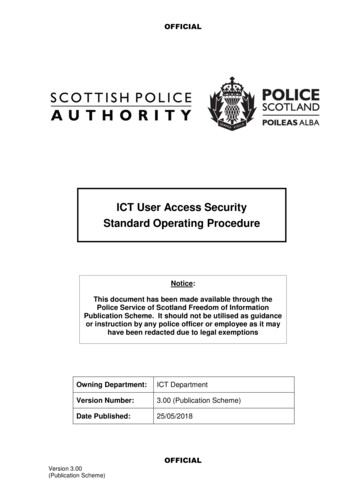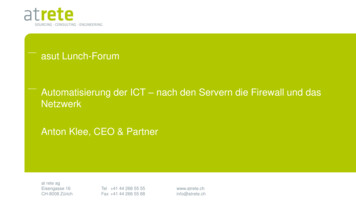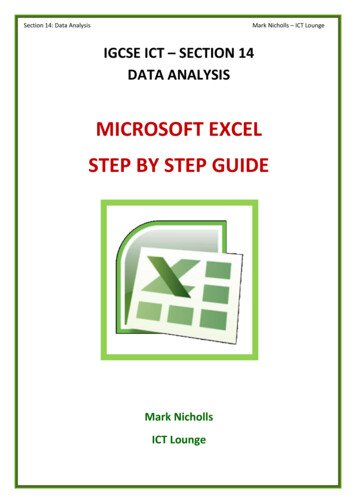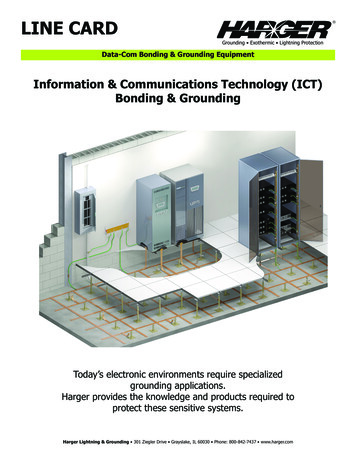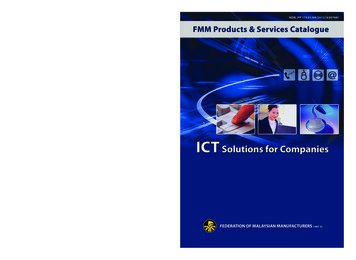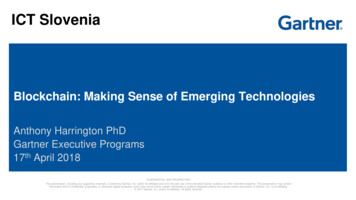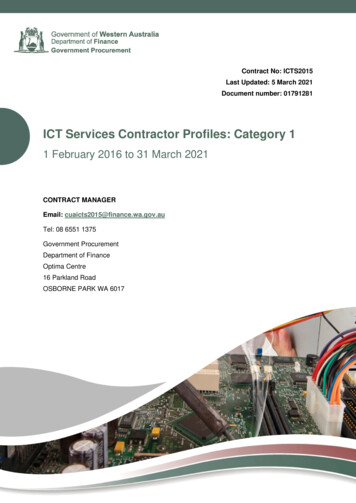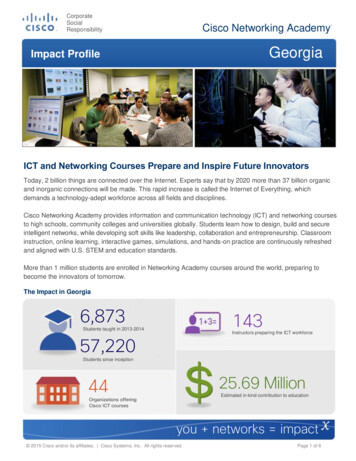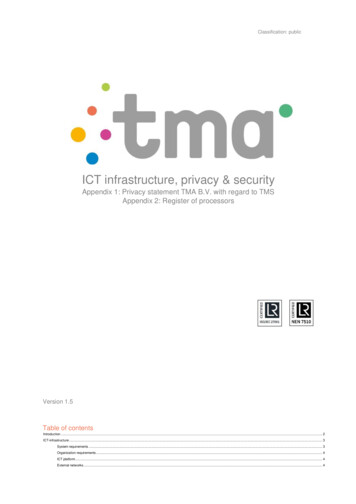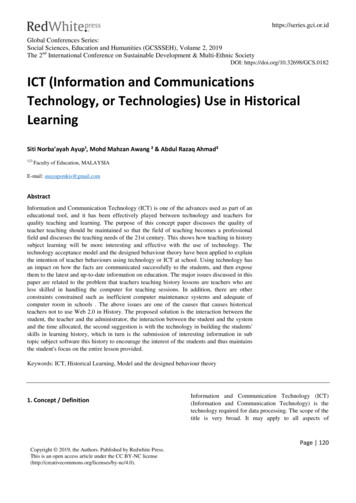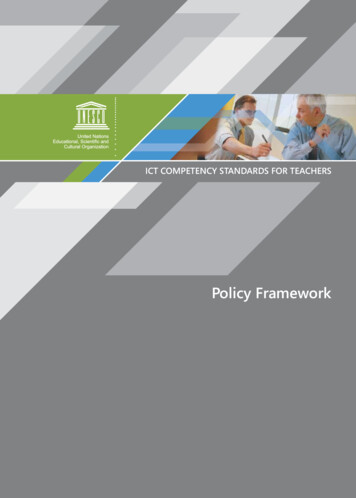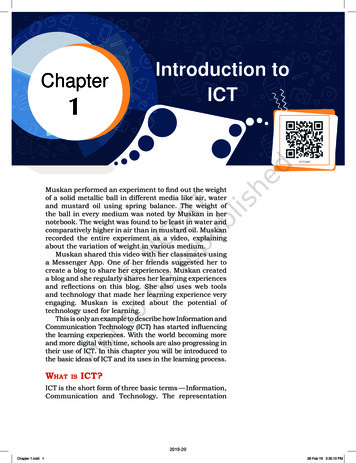
Transcription
Chapter1Introduction toICTMuskan performed an experiment to find out the weightof a solid metallic ball in different media like air, waterand mustard oil using spring balance. The weight ofthe ball in every medium was noted by Muskan in hernotebook. The weight was found to be least in water andcomparatively higher in air than in mustard oil. Muskanrecorded the entire experiment as a video, explainingabout the variation of weight in various medium.Muskan shared this video with her classmates usinga Messenger App. One of her friends suggested her tocreate a blog to share her experiences. Muskan createda blog and she regularly shares her learning experiencesand reflections on this blog. She also uses web toolsand technology that made her learning experience veryengaging. Muskan is excited about the potential oftechnology used for learning.This is only an example to describe how Information andCommunication Technology (ICT) has started influencingthe learning experiences. With the world becoming moreand more digital with time, schools are also progressing intheir use of ICT. In this chapter you will be introduced tothe basic ideas of ICT and its uses in the learning process.WhatisICT?ICT is the short form of three basic terms — Information,Communication and Technology. The representation2019-20Chapter 1.indd 128-Feb-19 3:30:10 PM
of data in a meaningful way is called Information.For example, Muskan is a student of Class IX of theGovernment School, Tajpur. She is 14 years old andis a Table Tennis player. Her hobbies include singing,drawing, reading, dancing, gardening, etc. This is thedescription about Muskan available in her profile atschool. Based on this information, Muskan's teacherselected her to participate in an inter‑school postermaking competition‑on “Dance forms of India”.Thus information (meaningful data) can help indecision‑making also.The term communication may be referred asimparting or exchanging of information by speaking,writing, or using some other medium. In other words,it may be referred as conveying your feelings, thoughtsand emotions in any verbal and non-verbal medium.Any communication has four essential elements,namely ‘sender’, ‘message’, ‘medium’ and ‘receiver’.When all four elements are in sync with each other interms of sequence, relevance, appropriateness, etc.,then communication becomes effective. Analyse theelements of communication followed when Muskanshared the video of experiment she recorded.Activity 1Identify the information communicated throughFigure 1.1.ICT Textbook — Class IX22019-20Chapter 1.indd 228-Feb-19 3:30:10 PM
Figure 1.1: Coast SceneSource: https://goo.gl/ZsTCaqTechnology refers to methods, systems and devices,which are a result of scientific knowledge, being usedfor practical purposes. For example, Muskan went toan excursion to Bhubaneswar and visited the StateMuseum. She saw various mineral ores in the mineralsection of the museum. She decided to capturephotographs to share with others who may not haveseen the ores. She borrowed her teacher’s mobile andclicked pictures of the rare collection. She shared all thepictures on her blog along with a description of the ores.Many viewers commented and appreciated Muskan forsharing those pictures and description.Technology can be used for creation andcommunication of information. The term Informationand Communication Technology (ICT) includes variousforms of technologies that are used to create, display,store, process, transmit, share or exchange informationby electronic means (UNESCO 2007). Such a disciplinewhich deals in the creation and communication ofinformation is called ICT (see Fig.1.2).Radio, television, and print media (Newspaper,Books, Magazines, etc.) are the popular technologiesused for communication. The digital revolution hastransformed the way these traditional technologiesfunction. For example, analog television has becomeIntroductiontoICT32019-20Chapter 1.indd 328-Feb-19 3:30:11 PM
Figure 1.2: ICT around usSource: https://goo.gl/vytpr7digital television. In addition to printed newspapersnow we also have their electronic versions. Along withtraditional radio, we also have online radio.Evolution of ICTWe cannot live in isolation. We need to interact andcommunicate with each other and with our surroundings.In the ancient times people used smoke signals,drum sounds, pigeons and messengers as modes ofcommunication. These were relatively slow, unreliableand sometimes unsafe means of communication.With the advent of new technologies, the modes andmethods of communication are changing very fast. Radio,television, computers, telephones, smartphones, digitalcamera, laptop and interactive board have revolutionisedthe ways of communication. These are very fast and canlink distant locations within no time.We can easily send messages across the globe andlearn about events all over the world in a blink of eye.Numerous technological tools have come up which help usnot only to communicate but to create, store and manageinformation. The diverse set of technological tools andresources used to store, manage, manipulate, create andcommunicate digital information come under informationand communication technologies (ICTs).ICT Textbook — Class IX42019-20Chapter 1.indd 428-Feb-19 3:30:12 PM
Why ICT?ICT facilitates communication anywhere, anytimeand by anyone. It has become easier to communicateworldwide through the use of ICTs, for example, socialmedia sites and apps, blogs, wikispace, etc. The use ofICT is time saving and cost effective in various ways.ICT has revolutionised the world. There was ageneration that did not have telephone; there was atime when radio and television were considered asthe most advanced sources of information. Howevernow the new generation lives in the world of Internet,wireless, augmented and virtual space. The worldaround has drastically changed. The dramatic changedue to ICT has resulted in innovation in every field.These innovations have reduced the size of thetechnological tools and increased the speed withwhich they operate to process data and communicateinformation.All these advancements and innovations give scopefor betterment and effectiveness.Muskan has a cousin Nishi who lives in Bengaluru andwho is also of her age. She has same hobbies like her,such as dancing and gardening. Both of them are veryfond of each other. They like to talk very often, theydiscuss about new things they do in gardening for hourstogether over phone. But making phone calls frequentlywas very costly and unaffordable for them.Hence they always had to restrict their discussions ongardening. A friend of Muskan informed her about onlinevideo calling facility like Skype, Google Hangout, etc.which is more cost effective than making, phone calls.Muskan installed Skype on her laptop and her cousinalso installed it on her Smartphone. They are now able todiscuss on several topics without any restriction. Access to instant data: Access to instant datasupports in predictions, decision making and alsoknowledge acquisition.IntroductiontoICT52019-20Chapter 1.indd 528-Feb-19 3:30:12 PM
Muskan’s family planned to go on a trip to Mount Abu.While packing, her mother was a little confused aboutcarrying woollen clothes as she was unaware of thetemperature in Mount Abu. Knowledge about ICT helpedMuskan to help her mother. She checked the temperaturein Mount Abu during the past few days from meteorologicalwebsite. As the recorded temperature showed a highertemperature for past 15 days, she informed her motherto carry more semi woolen clothes. Instant access to datahelped them to reduce the luggage and have a pleasantjourney with required preparedness. Creation of information for communication: ICTscan be used to create communication pieces in variousforms like text, image, audio, video, multimedia, etc.Once the information is in digital form it can be usedfor recreating resources out of the original. Digitalinformation is also easy to modify and share.Muskan’s cousin Nishi visited a historical place ‘Hampi’ inKarnataka. When she saw the beauty of the architectureshe thought of sharing it with Muskan.Nishi decides to show Muskan the archeological sitethrough skype, but her father suggested her to share itthrough Facebook live so that not only Muskan but herother friends can also see her exploration. As the mobilehad a 4G network, the speed of the Internet supportedonline streaming.This act of Nishi helped Muskan to have a virtual tripto Hampi. She thought for a while and found a solutionto make a great resource about Hampi that can beshared with others. So she downloaded the video sharedby Nishi. Using a video editor, she edited the unwantedcontent, added a background music and shared it withher schoolmates who never saw Hampi. The knowledge ofICT helped in capturing the events Muskan herself hadnever seen and sharing them through online streaming. Store and organise: ICT helps in organisinginformation in various forms. This organisation ofinformation helps in retrieving the required data.For example, in libraries, all the informationabout books are organised as database by usingmanagement software. When anyone wants to checkICT Textbook — Class IX62019-20Chapter 1.indd 628-Feb-19 3:30:12 PM
the availability of books, it is easy to search in thedatabase and find the availability.Muskan's grandfather had a great collection of postagestamps. He gifted his collection to Muskan on her birthday.She was thrilled to get this collection but she observedthat the collection compiled in an album will perish overtime. She decides to give the collection a lasting life byconverting it into a digital collection. She along withher brother scanned all the stamps and added tags likecountry to which they belonged, date of release, event,personality, phenomenon depicted on the stamp, etc. Thisdigital storing and organising helped her to retrieve anystamp whenever she require and also to easily maintain therecord. Scope for learning: ICT provides a great opportunityto learn. One can learn anytime, anywhere and athis or her own pace. We can also create our ownpersonal learning environment. Availability of onlinecourses, e-tutorials have opened up avenues forcontinuous and life‑long learning.Muskan used to visit her grandmother's place for everysummer vacation, but this summer her parents were busywith some work. She could not visit her grandmother.She was very sad and did not know what to do during hersummer vacations. Hasmukh, a friend, suggested her todo an online course on Puppetry. He sent her informationabout this free course. When she further searched aboutthe course she found it to be a Massive Open OnlineCourse (MOOC). As she was not aware of MOOC, shesearched for information about MOOC and learnt thatMOOCs are free online courses that can be taken upby anyone at anytime from anywhere. Muskan joinedthe course immediately and started learning differentpuppet‑making techniques as well as storytelling usingpuppets. She enjoyed the online course on puppetry andplanned to do a puppet show in her class as a holidayproject once the school reopens. Plan and manage : Use of ICT tools can help in timemanagement by scheduling the works across devicesand using various features like alerts, priorities,IntroductiontoICT72019-20Chapter 1.indd 728-Feb-19 3:30:12 PM
highlights, etc. ICT tools can also be used in planningand managing the activities.Muskan often forgets the deadlines of returning booksissued from the library. To avoid paying fines, she setsthe dates in her father's mobile using a calendar mobileapp. Also she schedules her exam dates using a digitalcalendar.Activity 2Discuss with your friends, parents and other peoplein your surroundings about how ICT is essential intheir daily life. Note down the main points emerged.HOW ICT IS USEFUL?ICT has wide range of applications for the society butthe extent of its use depends on the user. ICT has itsexistence in all fields. Some of the fields are shown inFig. 1.3.Figure 1.3: Applications of ICTICT Textbook — Class IX82019-20Chapter 1.indd 828-Feb-19 3:30:12 PM
1. Application of ICT in Everyday LifeICTs have become a way of life in the present day world.We are using various ICTs in our day-to-day life forreading e-newspapers, e-magazines and e-books, onlineshopping, paying bills for food, using mobile apps,getting online appointments from doctors and so on.Activity 3Write a few observations on the uses of ICT at home.2. Application of ICT in Educationa. Teaching, Learning and Assessment: ICTfinds presence and expression in almost all thefunctions of the schools, such as admission,time table, classroom instruction, evaluation,laboratory management, learning resourcesmanagement, examination and certification. It isalso being used for office automation. E‑resourceslike websites, e-books, e-newsletters, OpenEducational Resources (OERs), etc., are used bymost of the schools.b. Inclusive Education: ICT is used for cateringto the educational needs of every section of thesociety, including children with special needs.Various assistive devices and technologies arebeing developed which play an important rolein fulfilling the specific needs of these children.For example, talking books, talk back feature ofmobile phones, GPS inbuilt walking sticks, etc.,are making substantial changes in people's lives.3. Application of ICT in Art: Creative construction andconnection are being done in various domains with theadvent of ICT. Creative composition, compilation andcommunication can be done quickly by compatibleICTs. The role of ICT is vital in disseminating various artforms popular in one area to another. The appreciationof Art and Culture gained popularity through ICT. ICThas made it possible to showcase the creative works tothe larger audience.IntroductiontoICT92019-20Chapter 1.indd 928-Feb-19 3:30:12 PM
Activity 4Write a few observations of ICT use in areas relatedto art and culture.4. Application of ICT in
Introduction to ICT. Chapter. 1. Chapter 1.indd 1 28-Feb-19 3:30:10 PM. 2019-20. 2. C . EX T BOOK — C. LASS. X. of data in a meaningful way is called Information. For example, Muskan is a student of Class IX of the . Government School, Tajpur. She is 14 years old and is a Table Tennis player. Her hobbies include singing, drawing, reading, dancing, gardening, etc. This is the description .
